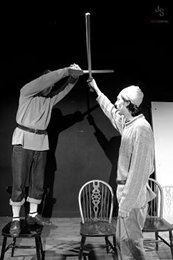What is it that marks and preserves history? What forces circumscribe and maintain meaning? Such questions, posed by Side-Show’s second production, are pertinent to the play’s inspiration: the filming of the MGM flop King Alfred the Great in Galway, 1968. A massive event at the time, employing thousands of locals as extras, the film has been widely forgotten - ostensibly because of its failure at the box office.
The relationship between the play’s title and its content seems tenuous. Set in Galway 2012, two moderators - played with deadpan humour by Guinnane and Tivnan - lead four volunteers in a focus group concerning “the mystery of history” and “the history of mystery.” The opening moments set the tone for a work replete with clever wordplays and metatheatre. Before the volunteers enter, the moderators remind us to "act as normal as possible." Nolan, Monahan, Rogers and Lynch embodied the participants’ expectant awkwardness, exchanging furtive looks and appearing aware of scrutiny; at this point, Mike Burke’s lighting became harsh, further adding to the audience’s self-conscious voyeurism.
After some farcical preliminary questions, the volunteers are left alone to ponder the function of the experiment - until the Irish Man bursts in to tell them the ‘whole story’, recalling the summer of 1968. Ironically, though, his rendition is full of gaps and repetitions: the character personifies the amnesia of public consciousness. Oisin Robbins offered a hilarious caricature as the Irish Man, his selective dependence on his cane perhaps pointing to the selectivity of history. Left with little else to do, the characters begin to enact a variety of scenarios, including scenes from King Alfred the Great. The actors were highly entertaining in their various roles; Lynch’s incarnation of Ian McKellen (who had his film debut with King Alfred the Great) provided one comic highlight.
 Combining music, song and role-play, the work transcends its defining labels through the cumulative creation of an echoing, pulsating madness. This will be frustrating for those who desperately cling to expectations inscribed by the play’s title and opening. But, if we allow ourselves to be liberated from these slippery markers, the experience can be utterly exhilarating.
Combining music, song and role-play, the work transcends its defining labels through the cumulative creation of an echoing, pulsating madness. This will be frustrating for those who desperately cling to expectations inscribed by the play’s title and opening. But, if we allow ourselves to be liberated from these slippery markers, the experience can be utterly exhilarating.
Playwright Martin Sharry has long been interested in theatre that breaks the mould; his script here is highly original in its complex yet playful wit. Hollow clichés are exchanged along with clever contradictions and insights. Phrases such as "maybe the going is telling in itself" reveal the shaky links between actions and words, and the limitations of language as a communicative tool. At times, the dialogue seems to anticipate and reflect what some viewers may be feeling. This is exemplified in the lines "we’ve been sitting around talking shite for the past two and a half hours; we’re just a little frustrated, okay?" However, the power of Sharry’s text lies in its status as an unfulfilled search for meaning. Dick Walsh’s direction skilfully harmonised with this. The delivery of dialogue was often at odds with its content; stories of personal tragedies, for example, were expressed as if they had been learnt off. Such features helped to further expose the mutability of sense in language.
Walsh’s video installation, entitled Witnesses to 1968, accompanied the production. This is a series of interviews with local people involved in the making of King Alfred the Great and, as such, it offers a more clearly defined ‘history’ than Sharry’s mystery play, which evades meaning in order to hone feelings such as discomfort, amusement and excitement. While the documentary resurrects a significant portion of local history, the play offers a multi-layered theatrical experience - promoting a heightened awareness of self in the moment and revealing the arbitrary relations between life and its labels.
Siobhán O’Gorman teaches at the National University of Ireland, Galway, where she has just completing her doctorate in contemporary theatre.